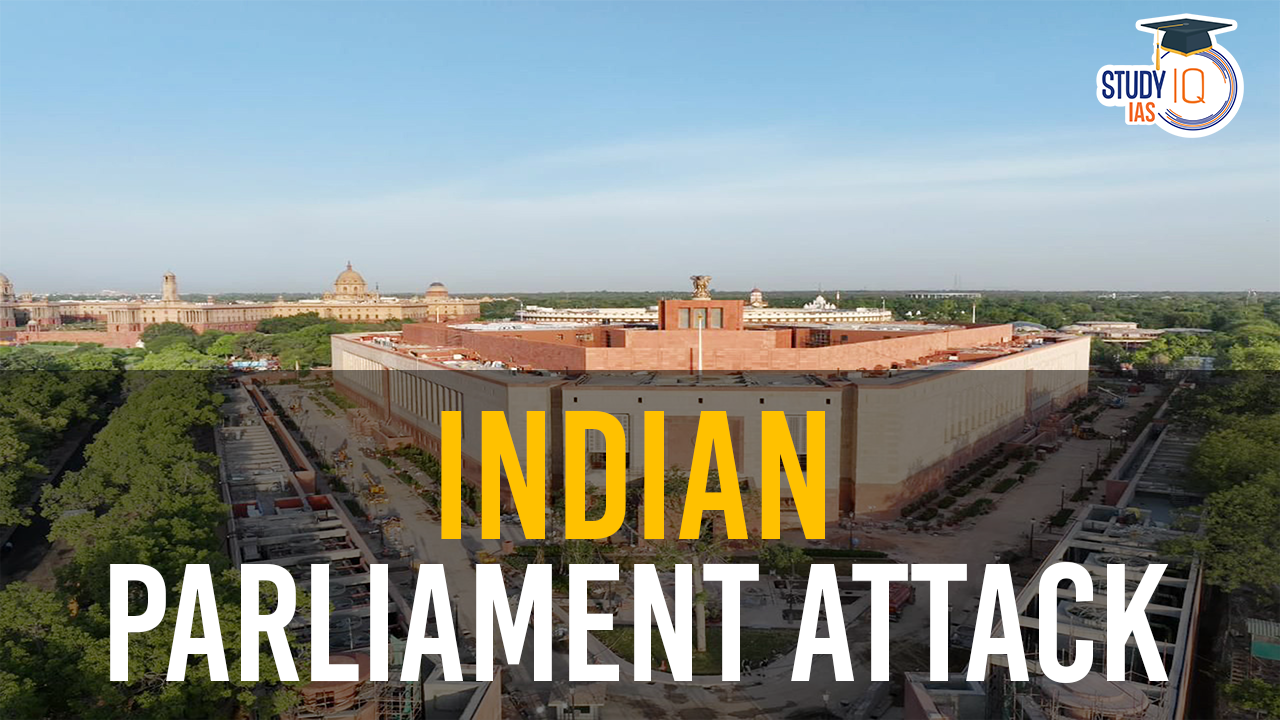Table of Contents
Indian Parliament Attack
In a stark security breach on the anniversary of the 2001 Parliament attack, two individuals infiltrated the Lok Sabha, releasing yellow smoke from canisters. Seated in the visitors’ gallery, the perpetrators, identified as Sagar Sharma and an undisclosed person, chanted anti-dictatorship slogans while moving towards the Well of the House. Detained soon after, their actions prompted a brief adjournment. The incident raised concerns over lapses in security, with the intruders managing to carry smoke sticks past checks.
We’re now on WhatsApp. Click to Join
History of Indian Parliament Attack
At approximately 11:30 AM, the heavily armed militants breached the security of the Parliament complex in New Delhi. Driving a white ambassador car, the attackers exploited fake VIP cards and a red beacon to infiltrate the compound, gaining access just 40 minutes after Parliament had adjourned for the day. Prime Minister Atal Bihari Vajpayee, Leader of the Opposition Sonia Gandhi, and other key figures had already left, while around 100 MPs, including Home Minister L. K. Advani, remained inside.
The terrorists’ vehicle collided with the Vice President’s motorcade, leading to an unplanned confrontation. A fierce firefight ensued between the terrorists and security personnel, lasting about an hour. In the exchange, all five terrorists were neutralized. Tragically, five Delhi police personnel, a Parliament security guard, and a gardener lost their lives, with approximately 22 others sustaining injuries.
Remarkably, despite the intensity of the attack, all ministers and MPs emerged unharmed. The incident was broadcast live on television by news channels, capturing the nation’s attention.
| Category | Details |
| Date and Time | December 13, 2001; Around 11:30 AM |
| Security Breach | Heavily armed militants from Jaish-e-Mohammad (JeM) and Lashkar-e-Taiba (LeT). White ambassador car with fake VIP cards and a red beacon. |
| Entry | Penetration of Parliament complex 40 minutes after adjournment. |
| Key Figures Present | Prime Minister Atal Bihari Vajpayee, Leader of the Opposition Sonia Gandhi had left. Approximately 100 MPs inside, including Home Minister L. K. Advani. |
| Confrontation | Terrorists’ car collided with the Vice President’s motorcade. Unplanned confrontation and heavy gunfire. |
| Duration of Attack | About 1 hour |
| Casualties | 14 deaths, including five terrorists. Five Delhi police personnel, a Parliament security guard, and a gardener were killed. Around 22 people were injured. |
| Targets | Aimed to enter the Parliament building and attack MPs and ministers. |
| Security Vulnerabilities Exposed | The incident highlighted shortcomings in security at the Parliament complex. |
| Broadcast | Televised live by news channels. |
| Investigations | Four individuals identified Afzal Guru, SAR Geelani, Shaukat Hussain, Navjot Sandhu |
| Legal Outcomes | Sandhu was convicted and sentenced to five years of rigorous imprisonment. Death sentences initially for Afzal Guru, SAR Geelani, and Shaukat Hussain. Geelani was acquitted; Hussain’s sentence was commuted to life imprisonment. Afzal Guru was executed on February 9, 2013. |
| Impact on India-Pakistan Relations | Strained relations, military escalations, and regional tensions. Pakistan officially condemned the attack but faced accusations of harbouring militants. |
2001 Parliament Attack
On the 22nd anniversary of the Parliament attack, Prime Minister Narendra Modi paid homage to the security personnel who lost their lives in the audacious assault that occurred exactly 22 years ago. This attack, orchestrated by Pakistan-based terrorist groups, not only claimed the lives of 9 individuals and injured 18 but also struck at the heart of Indian democracy.
Entry of Terrorists: At around 11:40 am, five terrorists entered the Parliament House Complex in an Ambassador car, equipped with a red light and a forged Home Ministry sticker.
Suspicious Encounter: As the car approached Building Gate No. 12, a Parliament House Watch and Ward Staff member became suspicious. He compelled the car to turn back, resulting in a collision with then Vice President Krishan Kant’s vehicle.
Commencement of Attack: Subsequently, the terrorists opened fire, triggering an alarm. All building gates were swiftly shut, initiating a firefight that lasted over 30 minutes.
Casualties: In the exchange, all five terrorists were killed, along with eight security personnel and a gardener. Approximately 15 people sustained injuries. Fortunately, the 100 ministers and MPs present in Parliament at the time remained unharmed.
Indian Parliament Attack: Pakistan’s Role
Statements by LK Advani: Then Home Minister LK Advani unequivocally attributed the terrorist assault to Pakistan-based outfits, Lashkar-e-Taiba (LeT) and Jaish-e-Mohammed (JeM). He highlighted the support and patronage these organizations received from the Pakistani Inter-Services Intelligence (ISI).
Investigation Findings: The police investigation confirmed that all five terrorists were Pakistani nationals. The suicide squad’s attack was jointly executed by LeT and JeM. Indian associates of the terrorists were apprehended in the subsequent days.
Government Initiatives After Indian Parliament Attack
- Coastal Security: Given high priority, coastal security was significantly strengthened through collaboration with the Navy, Coast Guard, and marine police. This aimed to prevent infiltrations through maritime routes.
- National Investigation Agency (NIA): In January 2009, the NIA was established as a specialized agency to address terrorist offences. It plays a crucial role in investigating and prosecuting terrorism-related cases.
- National Intelligence Grid (NATGRID): Formed to create a comprehensive database of security-related information, NATGRID facilitates effective information sharing among various intelligence and security agencies.
- National Security Guard (NSG): Four new operational hubs were established for the NSG to ensure a rapid and specialized response to terror attacks, bolstering the country’s counterterrorism capabilities.
- Multi-Agency Centre (MAC): Operating under the Intelligence Bureau, the MAC was strengthened and expanded to enhance coordination and intelligence sharing among multiple agencies.
- Joint Operations Centre (JOC): The Navy established a JOC to vigilantly monitor India’s extended coastline, acknowledging the significance of maritime security.
Way Forward
Despite these measures, terrorism continues to pose a significant threat. Modern refinements and evolving terrorist methodologies, coupled with the global reach of terrorism, necessitate a continuous commitment to preparedness. Key strategies for the way forward include:
- Automatic Identification Systems (AIS): Accelerate the installation of AIS in fishing boats to enhance tracking and monitoring capabilities.
- Marine Police Strengthening: Coastal states should fortify their marine police forces, ensuring they are well-equipped and adequately staffed.
- Regular Air and Coastal Sea Patrols: Conduct frequent patrols to monitor both air and coastal regions, preventing illicit activities and enhancing surveillance.
- Unity of Command and Control: Recognize the challenges of securing vast coastal areas and emphasize the importance of unified command and control for effective security.
- Continuous Preparedness: Acknowledge that while the likelihood of a repeat of events like 26/11 is debatable, ruling out such possibilities entirely would be premature. Therefore, maintaining and further tightening preparedness remains essential.
Indian Parliament Attack UPSC
The 2001 Indian Parliament attack, occurring on December 13, was a terrorist assault on New Delhi’s Parliament. Five armed assailants, driving an Ambassador car with a forged Home Ministry sticker, breached security at 11:40 AM. The attack claimed the lives of six Delhi Police personnel, two Parliament Security Service personnel, and one gardener while injuring 16 others, including 13 security personnel. This incident had significant repercussions, including its connection to major 2008 Mumbai attacks and involvement in various other high-profile incidents.


 Places in News for UPSC 2025 for Prelims...
Places in News for UPSC 2025 for Prelims...
 List of Indian State Animals with their ...
List of Indian State Animals with their ...
 World Heritage Day 2025, Theme, Objectiv...
World Heritage Day 2025, Theme, Objectiv...





















